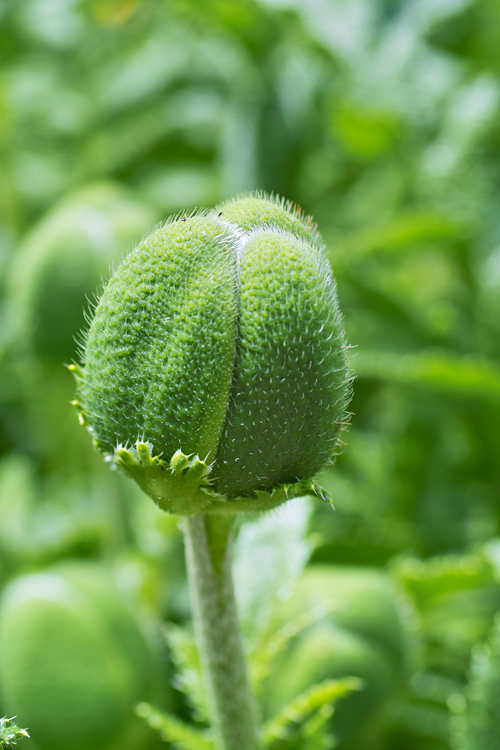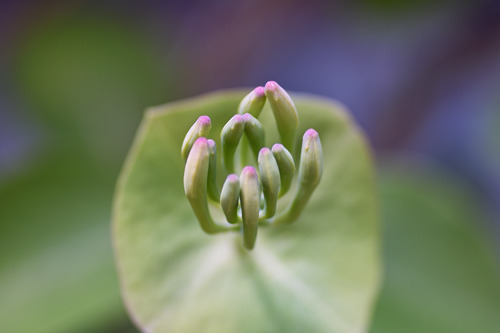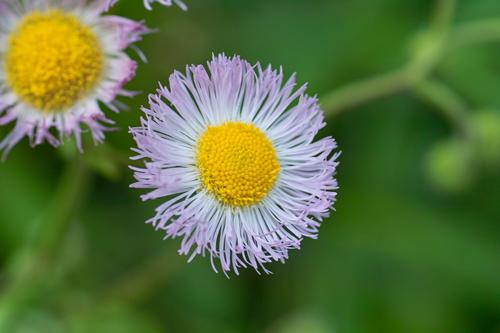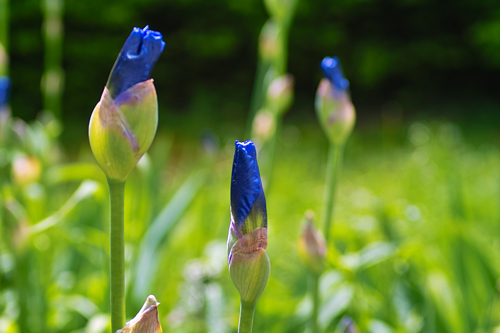Sample Images
It should be clear by this point that the SD14 is a camera that only
excels in deliberate photography. It is certainly not a camera for sports photographers
or the kids' soccer games. It is also not a great choice as a snapshot or travel
camera, although it is usable in those areas.
Where the SD14 does
excel is in photography where you have time to plan and time for post-processing
- or where capture settings are somewhat static and repeatable. For that reason
all of the sample images are macro shots. Everything was shot RAW and processed
in Sigma Photo Pro 2.5 or 3.0. 2.5 is the latest version of Photo Pro for the PC,
but 3.0 is the only PC version that can also process JPEG and TIFF images in addition
to the native RAW.
After processing in
Photo Pro, images were saved as 16-bit TIFF files and finally saved as highest-quality
JPEG files, with no further processing in Photoshop CS3. None of the images were
cropped, even though cropping would definitely improve a few of these images. This
allows close examination of the full frame for those who are interested.

















40 Comments
View All Comments
justascot - Wednesday, June 4, 2008 - link
Pinto if you are genuinely looking for an extra tool to complement the 5d that you already own then you may well be interested to read a comparison between the 5D and the SD14 as carried out by another user as found here http://www.ddisoftware.com/sd14-5d/">http://www.ddisoftware.com/sd14-5d/Personally I find Image quality to be a subjective thing. I own the SD14 myself and enjoy it but I would never try and suggest that it is always going to be a better camera than your 5D. Your 5D is capable of working in different areas than the SD14 but you may well find on occasions (if you like the IQ of the foveon look that is) that you will prefer to use the SD14 for certain subject matters but that depends on 3 factors - your shooting style, your photographic interests and your ability to see the difference between the foveon and the bayer image and most importantly that like what you see.
I'm not going to try and sell you a SD14 that should be Sigma's job, I just see the camera (whoever manufacturers it) as a tool in which to do a job. I happen to like the end result of what this tool is capable of in the areas that I have in interest in - that being landscapes, portraiture and IR. Having used this camera for a few months now and seen the images of other users I am also gaining more of an interest in macro. These are all areas in which the SD14 excels if you have an interest in any of those fields it might well be worthy of further consideration by yourself.
As for the Megapixels argument, I have little time for that between any manufacturer. The quality of the megapixels seems to vary greatly between camera and camera no matter whether a foveon or bayer chip is used. I know from experience that there is a lot of information in a raw foveon image that suggests it is greater than the 4.7MP that some say, but less than the 14MP that Sigma would like us to believe. There are some users that say they can get print up to A0 with a SD14 file, and Sigma have been known to do this themselves but personally I've never felt the need to print that extreme. A2, or perhaps on the rare occasion A1 would be perfectly adequate for my needs and for that the raw file of the SD14 is ideal. It takes a little bit of skill to get the most of the foveon file. In my experience I found the auto white balance wasn't good enough for my needs but after switching to custom white balance in camera I found the results improved dramatically.
My advise is to do your research and look at what others who own the SD14 are able to get out of it and decide from there. In the end that's what sold it for me. The cheap price although a factor in sparking my initial interest was also something that put me off to an extent but it was the photography of the long term users that persuaded me in the end not the marketing by Sigma or megapixels argument between bayer or foveon fans.
pinto4402 - Wednesday, June 4, 2008 - link
Your comments are well taken. Thank you for taking the time discuss this with me.justascot - Wednesday, June 4, 2008 - link
You are welcome. I hope whatever conclusion you come to, it proves to be the right decision for you.My apologies for my lack of spacing between paragraphs in my previous comment I hadn't realised my mistake until after I pressed send.
Wesley Fink - Tuesday, June 3, 2008 - link
WE WERE WRONG ABOUT START-UP.We used three different 8GB CF cards in the course of testing fro this review. All were 280X cards based on Samsung memory chips, and all 3 cards have worked fine with every other camera we have tested at AT.
After receiving several emails from SD14 users reporting startups of 1 second or so we tried two new CF cards of different brands - a 16GB and a 4GB. BOTH the new cards initialized in about a second and we have not experienced a lock-up yet in shooting with either card. THE STARTUP DELAY AND LOCK-UPS APPEAR TO BE THE FAULT OF CF CARD COMPATIBILITY ISSUES AND NOT THE SD!$ CAMERA.
We will revise the review shortly to reflect these findings and also update the lock-up issue as soon as we have had more time with the new cards.
justascot - Tuesday, June 3, 2008 - link
By on large as a Sigma SD14 owner of a few months I found this a fair and reasonable review, except on one matter. The experienced start up time of the author of this review puzzles me greatly. When I turn on my camera, within about a second its ready to go. If I had experienced an 8 second start up time I would have returned it to the shop in frustration. Sadly I'm not patient enough to deal with a start up time of that magnitude, thankfully I've not had to do just that. In fact the start up time has never been an issue for me. I'm not sure why the author experienced this issue, perhaps it was the 15 year old lens that was used although that seems unlikely.There are areas where the camera is slow, writing to card for instance - so for someone who is used to a quicker camera it does mean an adjustment in shooting styles.
Anyway about from the issue I highlighted it was a fair review. The Image quality of the camera is superb with good quality lens when combined with good skills of an experienced photographer. I would say the IQ compares favourably with the mid priced dslrs albeit at low isos, and with the current price of the SD14 it is a bargain, especially when you consider you have two cameras for the price of one if you are into IR. Most if not all other Dslrs require a permanent irreversible modification if you want to shoot in IR, whereas with the SD14 you can easily swap between regular colour and IR as your mood dictates.
I would never try to suggest this as a camera for everyone, its a specialist camera but if you have an interest in Landscape, Macro, portraiture and/or Infrared photography its well worth consideration for the image quality capabilities of the camera and the price - and unless something is very wrong it should be ready to shoot without contemplating whistling the first few notes of "Why are we waiting...."
Souka - Tuesday, June 3, 2008 - link
9 sec start up time? Probably running a flavor of Windows....crimson117 - Tuesday, June 3, 2008 - link
This is hardly primitive gear. As Wesley wrote in the review, since no other major manufacturer has used the Foveon sensor, it's impossible to know whether it's the camera design or just the sensor itself that is responsible for the slow response times.Your portrait photographer friends don't need a really quick camera, as portraits are usually carefully set up and controlled. Add in unbeatable image quality and it sounds like the right choice for a portrait photographer.
aeternitas - Tuesday, June 3, 2008 - link
Layer-per-primary is the future of digital photography. I can't wait till Canon or Nikon do the same, as they are bound to wrap more accurate hardware around the technology.For more pictures
http://reviews.photographyreview.com/blog/sigma-sd...">http://reviews.photographyreview.com/blog/sigma-sd...
s12033722 - Wednesday, June 4, 2008 - link
Layer-per-primary is definitely NOT the future of digital photography. It's a concept that sounds nice, but in practical application things are a lot muddier. The basic problem is that while the literature makes it sound like red photons go to one layer, green to another layer, etc, the reality is that you don't get nice discretely separated layers. Photons of a certain wavelength will generally penetrate silicon to a certain depth, but that depth varies based on a lot of factors, and photons come in a continous spectrum, not discretely separated wavelengths, so the reality is that you get a nice soup of photons all being absorbed in the "red" layer that may not be red at all. The sigma cameras are only able to produce their images through some very impressive image processing.If you want R, G, and B information at each pixel, there is a good way to do it: 3-CCD technology. Use a beamsplitter to image the same scene with 3 different imagers each filtered for one color. That will give you correct tri-color information at each pixel, but it costs a lot and it can be quite difficult to design.
Justin Case - Friday, June 6, 2008 - link
And has no real advantage over a single Bayer sensor with twice the height and width. Takes up (a lot) more space, cost more and is extremely hard to align (different wavelengths diffract differently).